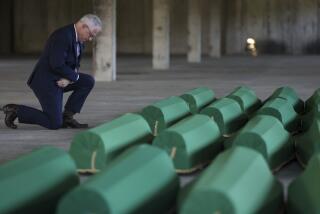Peace and hints of the troubled past in Croatia
- Share via
Osijek, Croatia — THE town of Osijek, now part of Croatia, quietly dreams away on the Drava River. I didn’t intend to come here last month when I visited Serbia, but my travel companion, Polly Platt, had to make a day trip to Osijek, about 150 miles northwest of Belgrade, to attend to some family business.
I like crossing borders, and this one held special interest. It separates westward-looking, largely Roman Catholic Croatia from Orthodox Serbia, the last bastion of the Yugoslav Federation.
On the 3 1/2 -hour bus ride across the great Pannonian Plain -- “splendid words, the flattest I know,” British journalist Rebecca West wrote in her 1942 book “Black Lamb and Grey Falcon: A Journey Through Yugoslavia” -- I read about the war that erupted in the region 15 years ago. Croatia claimed independence from the former Yugoslavia, pitting nationalists against the country’s ethnic Serbian population.
Before the 1995 Dayton peace accords ended the conflict, the Serb-led Yugoslav People’s Army had joined the battle to support its Croatian Serb comrades; both sides were accused of atrocities and ethnic cleansing; civilians fled their homes, bringing hundreds of thousands of desperate refugees to Balkan cities, including Belgrade.
I wondered whether a fence between the two countries would make them better neighbors. But the border came and went, marked only by a wooden gate where the bus was stopped on both sides for passport inspection.
Polly thought the farm towns in Croatia seemed more prosperous than the ones we had left behind in Serbia. But with their red-tiled-roof houses and gold-domed churches, they all looked alike to me -- except for the bullet holes in buildings on the Croatian side.
Along the way, Polly told me the story of her husband, Alexandre Grchich. He was a Croatian Serb who grew up partly in Osijek, an old Austro-Hungarian garrison town that was fortified to protect the empire from the Turks.
During World War II, Croatia allied itself with Nazi Germany and killed, interned or drove away most of its ethnic Serbian population. Polly said Grchich’s family was put in a concentration camp at Jasenovac because it refused to convert from Serbian Orthodox to Roman Catholic.
After the war, he left his homeland and the communist regime then in power to begin a long journey that eventually took him to France and to Polly.
He had begun the process of trying to regain the Grchich family house in Osijek when he died two years ago. Polly has since pursued the tangled legal claim, corresponding with a Croatian lawyer that she now wanted to meet. She had to feel encouraged: Partly motivated by its efforts to join the European Union, Croatia has recently enacted laws aimed at facilitating restitution for property owners who lost their homes or land.
*
Family matters
OSIJEK turned out to be a quiet, handsome town of about 115,000. Though hardly as popular a tourist destination as Croatia’s Adriatic coast, it has an 18th century fortress, the Museum of Slavonia, plentiful parks and a riverfront promenade. Nearby is Kopacki Rit, a nature preserve beloved by bird-watchers that’s at the confluence of the Drava and Danube rivers.
We spent most of the afternoon with Polly’s lawyer, whose office was on a wide, leafy avenue lined by recently renovated 19th century Hungarian Baroque and Viennese Secessionist mansions. He took us down the street to see the Grchich home, built around 1900 but now partitioned into shops and offices.
The fate of the property depends on a court decision, so we left with no assurances. But it was important for Polly to see the place where her husband grew up and lost his mother in a fire -- the first in a long series of tragedies that Polly said never succeeded in blighting his sense of humor.
For me it was important to see how quickly the region’s deep wounds appear to have healed.
*
(BEGIN TEXT OF INFOBOX)
Serbian sights
GETTING THERE:
From LAX, connecting service (change of planes) is offered on Lufthansa, British, American, Air France, Swiss and United. Restricted round-trip fares begin at $1,580. In the city, taxis and trams are plentiful and cheap.
TELEPHONES:
To call the numbers below from the U.S., dial 011 (the international dialing code), 381 (country code for Serbia) and the local number.
WHERE TO STAY:
Hotel Moskva, 1 Balkanska; 11-2686-255, www.hotelmoskva.co.yu, is an Art Nouveau landmark at the foot of Belgrade’s main pedestrian walkway, with 132 clean, old-fashioned rooms faintly echoing grander times; doubles $144, including breakfast.
Balkan Hotel, 2 Prizrenska; 11-3636-000, www.balkanhotel.com, is a recently privatized and renovated hotel across the street from the Moskva with an especially stylish restaurant and bar. Doubles from $144, including breakfast.
Le Petit Piaf, 34 Skadarska; 11-3035-252, www.petitpiaf.com, is a small boutique hotel with contemporary furnishings on a picturesque street in the old city. Doubles from $174, including breakfast.
WHERE TO EAT:
Tri Sesira, 29 Skadarska 29; 11-3247-501, and Dva Jelena, 32 Skadarska; 11-3234-885, are two pleasant, old-fashioned eateries on Skadarska street with grilled meats, Balkan wines and gypsy bands; at both restaurants, a three-course dinner with wine is about $10.
Stara Koliba, 11-3117-444, is a splavovi, or floating restaurant, near the confluence of the Sava and Danube rivers; fish dinner with wine about $10.
Orient Express in the Balkan Hotel (above) serves excellent continental fare and cocktails; entrees $5-$10.
TO LEARN MORE:
Serbia doesn’t have a tourist information office in the U.S. The National Tourist Organization of Serbia has its headquarters at 8 Deeanska, Belgrade; 11-3342-521, www.serbia-tourism.org.
The Tourist Organization of Belgrade, 1 Deeanska, Belgrade; 11-3248-404, www.tob.co.yu, also has an information office in the subterranean shopping gallery near Terazije and Kneza Mihaila; 11-635-622.
-- Susan Spano
More to Read
Sign up for Essential California
The most important California stories and recommendations in your inbox every morning.
You may occasionally receive promotional content from the Los Angeles Times.











